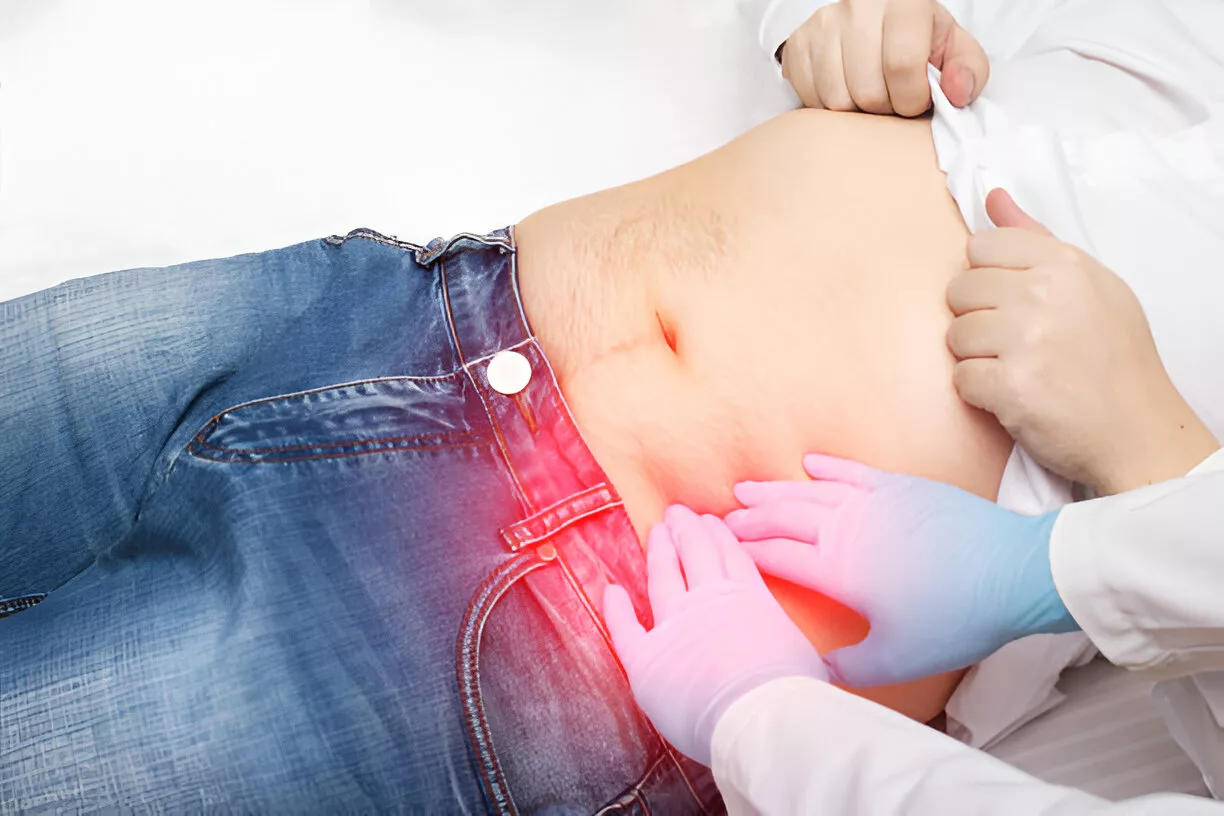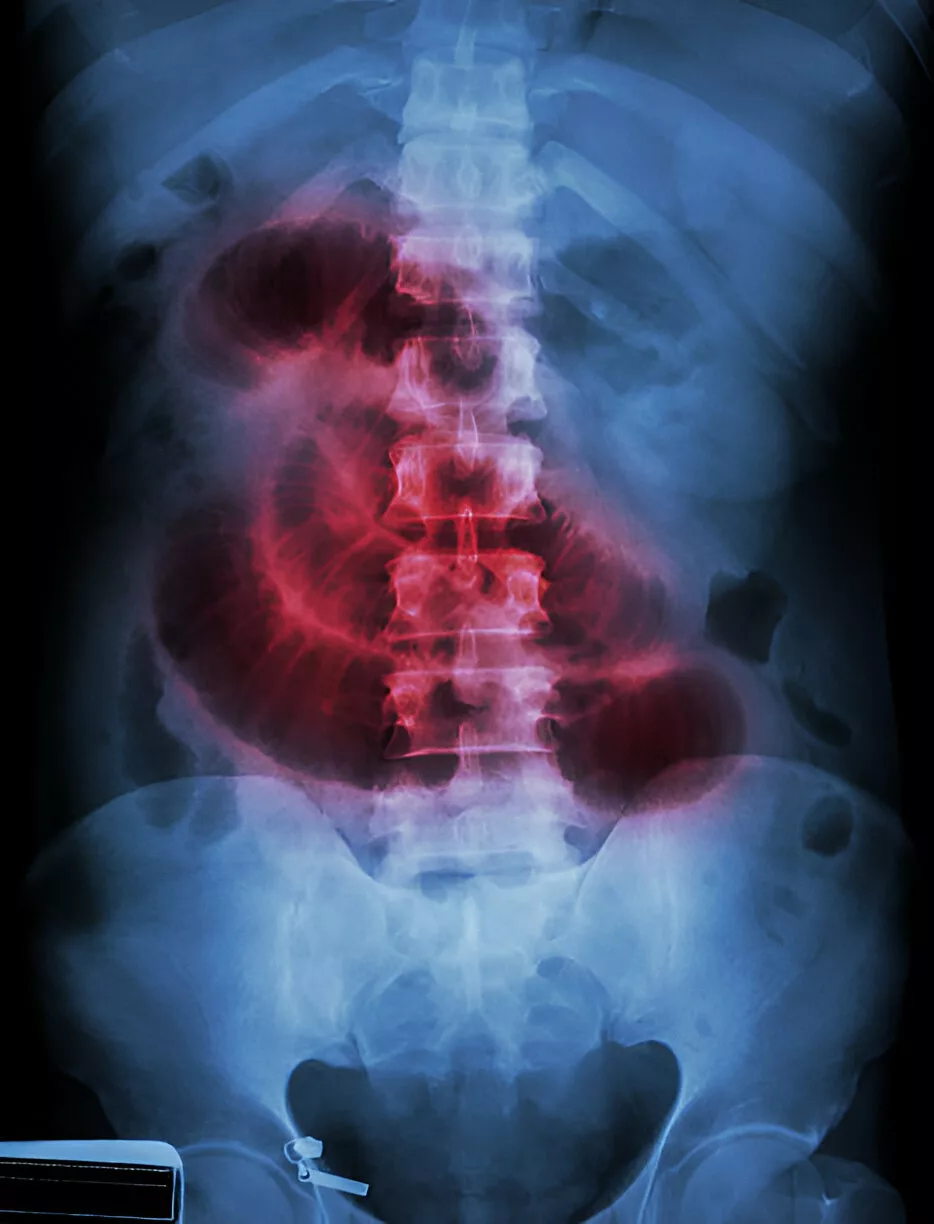Ileus is the disruption of the normal propulsive activity of the intestine. The exact mechanism is not fully understood due to the complex interplay of neural, hormonal, and inflammatory factors. It is a common, though sometimes preventable, consequence of retroperitoneal or abdominal surgery. Ileus can also occur in critically ill patients, especially those requiring mechanical ventilation or suffering from septic shock.1Beach, E.C. and O. De Jesus, Ileus. 2020.
The incidence varies widely depending on the type of surgery, the patient’s comorbidities, and perioperative management. Open abdominal surgeries—especially those involving the lower gastrointestinal tract—carry a higher risk, while laparoscopic procedures are generally associated with a lower incidence. Postoperative ileus usually resolves in stages, with small bowel function returning first (within 24 hours), followed by gastric emptying (within 48 hours), and finally colonic motility by the third to fifth day after surgery.2Vilz, T.O., et al., Ileus in adults: Pathogenesis, investigation and treatment. Deutsches Ärzteblatt International, 2017. 114(29-30): p. 508.
Types of Ileus
The term ileus is often incorrectly used to describe any bowel obstruction, but medically, it refers to a functional impairment of intestinal motility without a mechanical blockage. True ileus is also called paralytic ileus, while obstruction caused by a physical barrier is referred to as mechanical ileus or, more accurately, mechanical bowel obstruction.
Paralytic Ileus:
This is the most common type seen in clinical settings. It involves a temporary cessation of peristalsis, often triggered by abdominal or pelvic surgery, infections, metabolic disturbances, or certain medications. A specific and frequently encountered form is postoperative ileus, which occurs after surgery and typically resolves with conservative management over a few days.
Mechanical Ileus (Bowel Obstruction):
Although sometimes incorrectly referred to as “ileus,” mechanical obstruction is a separate condition caused by a physical blockage, such as adhesions, tumors, volvulus, or hernias. It requires prompt identification and, in many cases, surgical intervention.
Some other related terms are:
Meconium Ileus:
It affects only newborns. As the name indicates, the meconium is the first bowel movement or stool after birth. Some babies can also release the meconium during birth or in the womb. It is thicker than regular stool and can block the intestine. Meconium causes physical bowel obstruction, but is still called meconium ileus.
Gallstone Ileus:
It is a rare type of ileus and occurs when a gallstone travels from the gallbladder into the intestine. Just like meconium ileus, gallstone ileus is actually a physical obstruction
Causes of Ileus
The causes of the ileus have yet to be defined clearly, but several risk factors can increase its likelihood. 3Huge, A., et al., A model to investigate postoperative ileus with strain gauge transducers in awake rats. Journal of Surgical Research, 1998. 74(2): p. 112-118.
These causes include:
- Peritoneal carcinomatosis
- Perioperative complications
- Intra Abdominal inflammation
- Postoperative or intraoperative bleeding
- Sepsis or peritonitis
- Delayed enteral nutrition and nasogastric tube placement
- Hypokalemia
- Infections such as appendicitis or diverticulitis.
- Cystic fibrosis
- Injury to arteries
Various factors influencing the risk of ileus include pharmacological agents, medical conditions such as pneumonia and stroke, and electrolyte abnormalities.4Moghadamyeghaneh, Z., et al., Risk factors for prolonged ileus following colon surgery. Surgical endoscopy, 2016. 30: p. 603-609.
The medicines that can affect the intestine are:
- Opioids have been reported to cause decreased peristalsis and increased sphincter tone.5Kurz, A., & Sessler, D. I. (2003). Opioid-induced bowel dysfunction: pathophysiology and potential new therapies. Drugs, 63, 649-671.
- Tricyclic antidepressants have anticholinergic action. Anticholinergics such as atropine can decrease the motility of the intestine.
- Phenothiazines – These drugs have mild anticholinergic effects that may impair gut motility.6Beatson, N. (1982). Atropine and paralytic ileus. Postgraduate medical journal, 58(681), 451.
Pathophysiology
The complete mechanism of ileus is not yet understood. But it is believed that the development of ileus involves a neuroimmune response with two major phases:7Wehner, S., et al., Immune mediators of postoperative ileus. Langenbeck’s archives of surgery, 2012. 397: p. 591-601.
- The early neurogenic phase
- The inflammatory phase8Wehner, S., et al., Immune mediators of postoperative ileus. Langenbeck’s archives of surgery, 2012. 397: p. 591-601.
Right after the surgery, the nerves controlling the intestine react, leading to a slowdown or stop in the normal muscle movements of the gut. All this happens in the neurogenic phase. As soon as the immune system kicks in, the macrophages present in the walls of the intestine become active and release chemicals called cytokines. Cytokines attract more immune cells and increase inflammation in the inflammatory phase.
The nervous and immune systems constantly send signals back and forth, but communication ramps up when the bowel is handled during surgery. The stress from the surgery and the physical manipulation of the gut trigger the release of hormones and neurotransmitters, contributing to the further slowdown of the gut movements. Hence, the gut muscles cannot contract properly, leading to a temporary shutdown called ileus.9Gero, D., et al., Postoperative ileus: in search of an international consensus on definition, diagnosis, and treatment. Langenbeck’s archives of surgery, 2017. 402: p. 149-158.
Symptoms of Ileus
The common clinical manifestations of the condition include:
- Nausea
- Vomiting
- Delayed flatus
- Inability to pass gas (flatus)
- Inability to tolerate an oral diet
- Stomach pain and cramps
- Swollen or bloated stomach
- Loss of appetite
- Constipation

Diagnosis of Ileus
The healthcare provider will first ask for the symptoms and take a complete medical history to diagnose this condition.
History & Physical Examination:
The healthcare provider may inquire about your past and current medical conditions, any medications you are taking, and your surgical history. You may report symptoms such as bloating, which may present a sensation of fullness and visible swelling. The patient’s abdomen can be tympanic or distended on his physical exam, along with mild diffuse tenderness. Pain is generally persistent and diffuse without peritoneal symptoms. The sounds of the bowel are usually absent or sparse. However, doctors typically need imaging tests to confirm the diagnosis.
Imaging Tests:
Imaging tests help locate the ileus by highlighting intestinal abnormalities, like an enlarged intestine, gas buildup, or a physical blockage.
- An abdominal X-ray can show obstructions, but it can not specifically identify ileus.
- Computed tomography provides a more detailed view than standard X-ray images. The scan highlights an ileus, showing the intestines from various angles.
- Doctors can also diagnose children with a suspected ileus using an ultrasound scan, which usually shows a coiled part in the intestine.

Laboratory Evaluations:
- Laboratory investigations help identify any potential reversible causes, such as signs of infection or hypokalemia.
- A complete blood count will be performed to check for anemia and rule out elevated white count and bleeding.
- The electrolyte panel can look for any electrolyte irregularities.
- Liver function tests can also be performed. However, it is typically not a primary diagnostic tool, but it can help identify underlying conditions that can contribute to the ileus.
Treatment & Management of Ileus
Postoperative ileus is physiologic, but if it persists (more than 3 to 5 days), it requires proper management. The treatment of this condition often takes time and is usually supportive. Possible treatment and management options include:
- No food for three to four days will help your intestine rest and regain its ability to move its contents through.
- Intravenous fluid therapy helps correct the electrolyte imbalance. It will also help to regain the hydration status.
- Nasogastric decompression is used to relieve the buildup of gas or liquid. The doctor passes the nasogastric tube through the nose and into your stomach or small intestine. Suction is used to drain the liquid or gas.
- Prokinetics could resume the activity of your intestine, allowing it to push the contents forward.
- The healthcare provider can stop, change, or reduce strong pain relievers or other medications that may cause the symptoms. Decreasing the use of opiates and changing it to a multimodal pain regimen has benefits.
- Electrical stimulation can encourage movement in the intestine.
- Chewing gum is a cheap and well-tolerated method to help with ileus. It can stimulate the cephalocaudal reflex, which inhibits inflammation and promotes peristalsis.10Su’a, B.U., et al., Chewing gum and postoperative ileus in adults: a systematic literature review and meta-analysis. International Journal of Surgery, 2015. 14: p. 49-55.
- Sitting upright can help patients who have spent much time lying down.
- Dietary Progression – Once bowel activity begins to return, evidenced by passing gas or stool and the presence of bowel sounds, patients are typically started on a clear liquid diet. If tolerated, this is gradually advanced to full liquids, followed by soft or easily digestible foods. A return to a regular diet is guided by clinical improvement. A low-fiber diet is generally not necessary unless there is an additional condition, such as partial bowel obstruction or inflammatory bowel disease.
If the blockage is severe and medication or dietary changes can not resolve it, the person might need surgery, but this just happens in very rare cases.
The surgery can be of these types:
Resection:
The surgical process usually involves removing the impaired portion of the intestine.
Stents:
People with colon cancer or older adults are not suitable candidates for extensive surgery. So, they may fit a stent into the patient’s intestine to keep it open and allow bowel material to pass through easily.
Ostomy:
In rare cases, the surgeon may remove the entire intestine of the patient through a procedure known as an ostomy. The surgeon creates an opening in the abdomen called a stoma, allowing the stool to pass from the intestine to a pouch that gathers stool.
Prognosis
The overall prognosis from the ileus is good. The patients eventually recover, but the number of days till the return of bowel function is undefined.11Venara, A., et al., Postoperative ileus: pathophysiology, incidence, and prevention. Journal of Visceral Surgery, 2016. 153(6): p. 439-446.
Ileus can be harmful regarding length of stay and decreased nutrition, as extended hospital stays can increase the risk of nosocomial infections. Hence, a prolonged ileus can lead to the need for total parental nutrition, which has benefits and risks.
Complications of Ileus
Complications are rare. There is a possibility of aspiration with increasing vomiting and nausea. However, if left undiagnosed or untreated, ileus can lead to severe and life-threatening complications. Untreated ileus can lead to perforation or a hole in the intestinal wall.
Other complications can include:
Infection:
The contents of the bowel are full of bacteria. After leaking into the abdominal cavity, these contents can cause peritonitis (a severe infection). Peritonitis can lead to a condition called sepsis (a life-threatening infectious disease).
Necrosis:
Necrosis occurs when blood fails to reach the intestine, and the intestinal tissues weaken and die. The weak intestinal wall is susceptible to tears and causes the bowel contents to leak.
Ileus Versus Small Bowel Obstruction
Although both ileus and small bowel obstruction (SBO) involve disturbances in the normal flow of intestinal contents, the difference between ileus and small bowel obstruction is given in the table:
| Characteristics | Ileus | Small Bowel Obstruction |
| Statement | Ileus is a non-mechanical obstruction where the intestinal muscles stop working properly, leading to the buildup of contents. | Small bowel obstruction is a mechanical obstruction where a physical blockage prevents the passage of intestinal contents. |
| Causes |
|
|
| Symptoms |
|
|
| Imaging Findings |
|
|
| Treatment | Supportive management is the leading treatment option. Rarely require surgery | Often, surgery is required to remove the blockage. |
Final Thoughts
Ileus is usually a temporary condition. It must be distinguished from the other causes of nausea, vomiting, distention, and abdominal pain. After diagnosis, treatment is supportive with the management of triggering causes. Postoperative ileus is the common one. Steps can be taken to help prevent it, particularly in our elective or outpatient settings. Prevention of ileus is the duty of both the patient and their healthcare providers, including the nursing staff, physical therapists, and pharmacologists. Educating patients and encouraging ambulation and improved recovery after surgery can improve the patient’s understanding and compliance.
Refrences
- 1Beach, E.C. and O. De Jesus, Ileus. 2020.
- 2Vilz, T.O., et al., Ileus in adults: Pathogenesis, investigation and treatment. Deutsches Ärzteblatt International, 2017. 114(29-30): p. 508.
- 3Huge, A., et al., A model to investigate postoperative ileus with strain gauge transducers in awake rats. Journal of Surgical Research, 1998. 74(2): p. 112-118.
- 4Moghadamyeghaneh, Z., et al., Risk factors for prolonged ileus following colon surgery. Surgical endoscopy, 2016. 30: p. 603-609.
- 5Kurz, A., & Sessler, D. I. (2003). Opioid-induced bowel dysfunction: pathophysiology and potential new therapies. Drugs, 63, 649-671.
- 6Beatson, N. (1982). Atropine and paralytic ileus. Postgraduate medical journal, 58(681), 451.
- 7Wehner, S., et al., Immune mediators of postoperative ileus. Langenbeck’s archives of surgery, 2012. 397: p. 591-601.
- 8Wehner, S., et al., Immune mediators of postoperative ileus. Langenbeck’s archives of surgery, 2012. 397: p. 591-601.
- 9Gero, D., et al., Postoperative ileus: in search of an international consensus on definition, diagnosis, and treatment. Langenbeck’s archives of surgery, 2017. 402: p. 149-158.
- 10Su’a, B.U., et al., Chewing gum and postoperative ileus in adults: a systematic literature review and meta-analysis. International Journal of Surgery, 2015. 14: p. 49-55.
- 11Venara, A., et al., Postoperative ileus: pathophysiology, incidence, and prevention. Journal of Visceral Surgery, 2016. 153(6): p. 439-446.

